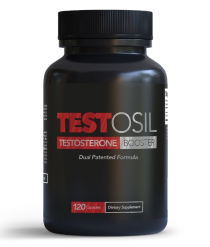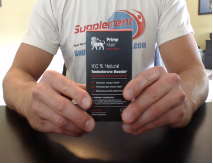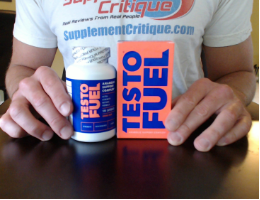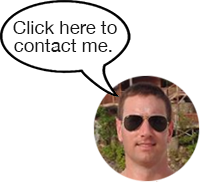Joovv Red Light Therapy for Testosterone – Should you Shine it on Your Junk?
By: Rob MillerHome » Testosterone Boosters » Joovv Red Light Therapy for Testosterone – Should you Shine it on Your Junk?
This is a review, Visit Joovv.comfor more info.
I’ve reviewed lots of testosterone boosters on this site in the past, mostly in the form of supplements.
But over the last year, I started hearing more and more about another strategy men are using to boost T-levels: red light therapy.
In this article, I’ll go over the basics of red light therapy: what it is, how it works at the cellular level, what the health benefits are, and how it affects testosterone levels.
Then I’ll give my personal review of one of the leading red light therapy devices on the market.
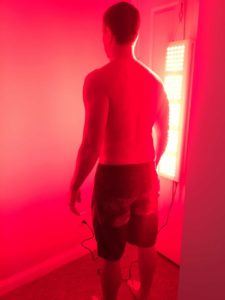
How I Heard About Light Therapy
I first heard about red light therapy last year when I read this Ben Greenfield story in Men’s Health about how Ben shined natural red light on his testicles and saw huge increases in his testosterone and sex drive.
It’s an entertaining article, but at first glance, it sounded pretty far-fetched.
Just shine some red light on your junk and voila: more testosterone, better sex, healthier skin, faster muscle recovery, less joint pain.
I almost expected Ben to say it made him a foot taller too.
I slipped red light therapy into the “sounds too good to be true” file in my brain.
Then I kept hearing other successful trainers, doctors, and athletes swearing by red light therapy for physical performance.
Everyone from NFL stars like Patrick Peterson and Von Miller, to UFC champion TJ Dillashaw, plus world-class trainers like Lacey Stone and the late great Charles Poliquin.
Lots of other major voices in health and fitness are raving about it too, like Dave Asprey, former bodybuilding champ Ben Pakulski, and Onnit founder Aubrey Marcus.
I decided I needed to do more homework on red light therapy.
So I tested out the device Ben Greenfield and all those fitness enthusiasts are using: it’s called a Joovv.
You can jump right to my personal review of the Joovv and red light therapy at the bottom.
For those of you like me who wanted more info on the science and how it works, I’ll start with an overview of light therapy and explain what the hard research says.
I’ve got a special section on just the testosterone treatment part of red light therapy too.
What is Light Therapy & How Does it Work?
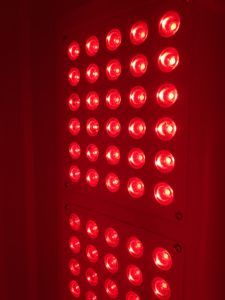
Red light therapy is also called photobiomodulation, or PBM.
It’s a non-invasive health intervention that delivers concentrated natural light to your skin and cells.
Specifically, the wavelengths of red and near infrared light that are the most therapeutic for human health (without harmful UV rays or unnecessary heat).
Light therapy works by delivering natural light to the mitochondria in your cells.
Those are the powerhouses churning out the ATP (adenosine triphosphate) energy our bodies need to function.
But here’s the problem: when you get sick, injured, stressed, or tired, your mitochondria produce too much nitric oxide, which slows everything down in your cells.
Nitric oxide competes with oxygen during the cellular respiration process that makes our ATP.
The photons in red and near infrared light excite the electrons involved in ATP creation, breaking up nitric oxide bonds and letting hydrogen and water move through the respiration process more easily.
The more efficiently your cells create ATP energy, the better your cells function on all levels and the better your body feels & performs.
Tldr: natural red light helps your cells make more energy, which helps your whole body run better.
Health Benefits: What the Science Says
I tried light therapy in part because there’s so much peer-reviewed clinical research that’s found it to be safe and effective.
It’s actually pretty incredible how many studies have been done for such a wide variety of applications.
These are some of the main health benefits that have been found in numerous clinical trials:
Training & Muscle Recovery
I’ve probably heard the most about light therapy from professional trainers who swear by it for muscle recovery and pain reduction after strenuous workouts.
A number of peer-reviewed studies have shown that by reducing oxidative stress and boosting ATP production, light therapy allows your tired and damaged muscle tissue to regenerate and recover faster. [1]
Research from 2016 in the American Journal of Physical Medicine and Rehabilitation showed light therapy also increased the growth of healthy muscle tissue among trial subjects, with increases in muscle size, bulk, and strength. [2]
Trainers and competitors I’ve talked to say light therapy is great on both ends of training: it helps with energy and motivation so you can go harder on a workout, and then it helps muscles recover so you can come back faster, without as much strain and injury risk.
That’s why you’re seeing NFL teams and Olympic trainers incorporating red light into their routines.
Less Inflammation & Joint Pain
Red light therapy is catching on in the training world, but it’s also a proven pain reliever for people with chronic issues like arthritis & fibromyalgia.
Several clinical trials have clearly shown that arthritic patients treated with light therapy see a significant reduction in inflammation and oxidative stress, with much less joint pain as a result. [3]
That’s one of the coolest things about red light therapy science: it works on your cells, and every single function of your body relies on cellular energy.
So whether you’re a champion bodybuilder in your prime, or a senior with joint pain, by getting more natural light to your cells, the increased ATP energy is going to be therapeutic and reduce inflammation.
Skin & Collagen
Red light therapy first got popular in spas and clinics because it’s a natural solution to skin blemishes and aging.
There’s a large body of clinical literature on how light therapy boosts your skin’s collagen. That’sthe key ingredient for things like skin health, hair health, and tendon & joint flexibility.
Patients treated with light therapy in clinical trials have seen improved skin tone & complexion, diminished signs of aging, and quicker healing of wounds and scars, without the range of side effects you see from more invasive and drug-based therapies. [4, 5, 6]
Safety
Obviously, it’s safety-first with a product you use directly on your bare skin.
Iwouldn’t try it if I didn’t think it was on the level, but the research has found almost zero problems with natural red & near infrared light.
A 2013 analysis of light therapy treatments conducted by Harvard and MIT researchers cited its “noninvasive nature and almost complete absence of side effects.” [6]
Light Therapy for Testosterone
The muscle, skin, & inflammation benefits of red light therapy are well-established in the medical science community, but newer research is also showing natural light has a big effect on a man’s testosterone levels.
This section is a top-level summary of what the hard research says about light therapy and testosterone.
2016 Italian Sex & Testosterone Pilot Study: A few years ago, researchers at the University of Siena in Italy conducted a very encouraging pilot study on light therapy and testosterone & sexual satisfaction in men. The subjects were 38 men with very low sex drive, split into two groups, with only one receiving clinical doses of light therapy every morning.
The men in the group treated with more light saw their testosterone rise significantly.
More specifically, the control group did not see T gains, but the active light therapy group showed a huge increase from about 2.1 ng/ml to 3.6 ng/ml in just 2 weeks. [7]
The study’s author elaborated in a Science Daily article: “The increased levels of testosterone explain the greater reported sexual satisfaction.
In the Northern hemisphere, the body’s testosterone production naturally declines from November through April, and then rises steadily through the spring and summer with a peak in October.
You see the effect of this in reproductive rates, with the month of June showing the highest rate of conception.
The use of the [light therapy device] really mimics what nature does,” said Dr. Andrea Fagiolini. [8]
Male Fertility
Several other studies around the world have found that light therapy on a man’s testes and sperm increases how well individual spermatozoa can swim.
As a result, many researchers are concluding that light therapy can have a significant effect on treating male infertility. [4,5,6,7 T] A 2017 study published in Scientific Reports also noted that these treatments were safe, and did not cause any oxidative DNA damage to the sperm or testes. [8 T]
Earlier Research on Testosterone in Mammals: Often the best research on human health starts in the laboratory with other mammals whose biology is similar to ours.
Two separate trials in 2013 found that lab rats had higher testosterone levels after prolonged exposure to natural light.
Other studies of boar and dog reproduction found that light therapy improves sperm health & fertility outcomes. [9,10,11,12 in T]
How Does Light Therapy Boost Testosterone Levels?
Many of these studies are showing that red and near infrared light wavelengths stimulate the Leydig cells in the testicles, which are responsible for producing testosterone. [6, 9,10 T] Researchers from the Italian pilot study theorized that light therapy interacts with the pineal gland in the middle of the brain, which also plays a major role in reproduction. [14 T]
One of the 2013 studies on mammals showed that the follicle-stimulating hormone (FSH) and luteinizing hormone (LH) were elevated in lab rats.
The FSH & LH are essentially the same in humans, and they’re called “gonadotropins” because of their ability to stimulate testicular function. [10 nepal study?]
More research is coming out and larger samples are needed going forward, as well as FDA clearance specifically for testosterone therapy.
But it’s pretty clear, based on the available research and anecdotal evidence from professionals, that natural light has a positive effect on male testosterone and sexual health.
That brings me to my personal experience with the Joovv light therapy device.
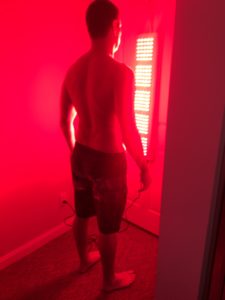
My Personal Experience With The Joov Light
I got a chance to try out the Joov light awhile back, and finally had a chance to put together my thoughts on paper.
At first glance, it’s a bit intimidating.
I don’t mean that in the literal sense, but more in the sense of the questions I had linkgering in the back of my mind:
Questions like:
“Is this even safe?”
“Can I look at the light, or will my retinas burn out?”
“Should I wear sunscreen?” (not really, of course)
I’ve never used a red light therapy machine like this before, so I wasn’t really sure what to expect.
I actually went into my test with the assumption that it likely won’t have much of an effect, mainly because I’ve been burned (again, not literally!) by products like this before.
My first session in front of the Joov Light lasted about 10 minutes, and while it was a bit boring standing there butt-naked, it was actually surprisingly relaxing.
After the session was over, I went back into my office and basically felt like I spent the day at the beach.
It was that type of warm afterglow you get from a good day of sitting in the sun, drinking cocktails (minus the actual tipsiness that a day like that can provide).
Apart from that afterglow feeling, I didn’t really notice much else, which was to be expected.
Throughout the first week, I religiously devoted 10 min. of my day to standing in front of this light.
As the week progressed, I have to admit, I did seem to start feeling better overall.
It wasn’t necessarily a “wow, I feel like I just injected myself with a big dose of Androgel!” type of feeling.
More of a “I feel content, calm, and just in general a lowering of anxiety”.
It wasn’t until the 2nd week hit that I really started to notice some changes.
The biggest thing I noticed was I was sleeping a lot better.
Normally, my sleep cycle is pretty good.
My biggest issue is I can never seem to stay asleep for more than 5 – 6 hours straight.
I’ll wake up, have to pee, and while I do fall back asleep, when I wake up 2 – 3 hours later I feel like I literally slept 2 or 3 hours.
This was not the case in week 2.
I was quite literally sleeping a sound, deep, 7 – 8 hours of very restful sleep.
The kind of sleep that, when you wake up, you feel ready to attack the day with the vigor of a 19 year old kid on his day off from work.
I also had a boner standing at full attention, which was more than a pleasant surprise.
Note that I hadn’t changed any of my sleep routine here…
I wasn’t taking any supplements, sleep aids, working out more strenuously, or doing anything different.
The only thing I was doing was using the Joov light 10 min. a day…
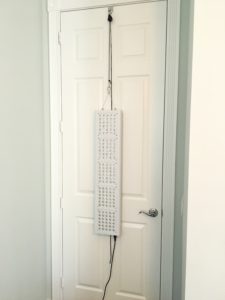
While I only used it for another couple of weeks, the benefits seemed to persist.
I was sleeping better, waking up with morning wood, and even noticed a little bit of increased muscle.
Was this all the result of an increase in testosterone? I can’t be sure…
But it sure as hell felt like it!
Visit Joovv.comfor more info.
Sources & References:
[1] de Almeida P1, Lopes-Martins RA, De Marchi T, et al. “Red (660 nm) and infrared (830 nm) low-level laser therapy in skeletal muscle fatigue in humans: what is better?” Lasers Med Sci. 2012 Mar;27(2):453-8.
[2] Ferraresi C, Bertucci D, Schiavinato J, et al. “Effects of Light-Emitting Diode Therapy on Muscle Hypertrophy, Gene Expression, Performance, Damage, and Delayed-Onset Muscle Soreness: Case-control Study with a Pair of Identical Twins.” Am J Phys Med Rehabil. 2016 Oct;95(10):746-57.
[3] Michael R.
Hamblin. “Mechanisms and applications of the anti-inflammatory effects of photobiomodulation.” AIMS Biophys. 2017; 4(3): 337–361.
[4] Ferraresi C, Hamblin M, and Parizotto N. “Low-level laser (light) therapy (LLLT) on muscle tissue: performance, fatigue and repair benefited by the power of light.” Photonics Lasers Med. 2012 November 1; 1(4): 267–286. doi:10.1515/plm-2012-0032.
[5] Emília de Abreu Chaves M, Rodrigues de Araújo A, Piancastelli ACC, and Pinotti M. “Effects of low-power light therapy on wound healing: LASER x LED.” An Bras Dermatol. 2014 Jul-Aug; 89(4): 616–623.
[6] Avci P, Gupta A, et al. “Low-level laser (light) therapy (LLLT) in skin: stimulating, healing, restoring.” Seminars in Cutaneous Medicine and Surgery.
Mar 2013; 32(1): 41-52.
[7] Fagiolini A et al.
Lack of interest in sex successfully treated by exposure to bright light.
European College of Neuropsychopharmacology.
Sept 2016.
[8] European College of Neuropsychopharmacology (ECNP). “Lack of interest in sex successfully treated by exposure to bright light.” ScienceDaily.
ScienceDaily, 18 September 2016.
[9] Vladimirovich Moskvin S., Ivanovich Apolikhin O.
Effectiveness of low level laser therapy for treating male infertility.
Biomedicine (Taipei). 2018 June; 8(2):7.
[10] Ban Frangez H., Frangez I., Verdenik I., Jansa V., Virant Klun I.
Photobiomodulation with light-emitting diodes improves sperm motility in men with asthenozoospermia.
Laser in Medical Science, 2015 Jan;30(1):235-40.
[11] Salman Yazdi, R., Bakhshi, S., Jannat Alipoor, F. et al.
Effect of 830-nm diode laser irradiation on human sperm motility.
Lasers Med Sci. (2014) 29: 97.
[12] Chow KW, Preece D, Burns MW.
Effect of red light on optically trapped spermatozoa.
Biomedical Optics Express. (2017) Aug 23;8(9):4200-4205.
[13] Preece D., Chow KW, Gomez-Godinez V., Gustafson K., et al.
Red light improves spermatozoa motility and does not induce oxidative DNA damage.
Scientific Reports. 2017 Apr 20;7:46480.
[14] Ahn JC, Kim YH and Rhee CK.
The effects of low level laser therapy (LLLT) on the testis in elevating serum testosterone level in rats.
Biomedical Research. 2013; 24(1):28-32.
[15] Biswas NM, Biswas R, et al.
Effect of continuous light on spermatogenesis and testicular steroidogenesis in rats: Possible involvement of alpha 2u-globulin.
Nepal Med Coll J. 2013;15(1):62-64.
[16] Yeste M., Codony F., Estrada E., Lleonart M., et al.
Specific LED-based red light photo-stimulation procedures improve overall sperm function and reproductive performance of boar ejaculates.
Scientific Reports. 2016 Mar 2;6:22569.
[17] Corral-Baqués M., Rigau T., Rivera M., Rodríguez JE, Rigau J.
Effect of 655-nm diode laser on dog sperm motility.
Lasers in Med Science. 2005;20(1):28-34.
[18] Aliendri V., Spina V., Morini A. The Pineal Gland and Reproduction.
Human Reproduction Update.1996 May-Jun;2(3):225-35.
Top 3 Testosterone BoostersAffiliate Disclosure
Testosil is the most effective testosterone boosting supplement on the market that I’ve tested.
Prime Male is another very effective testosterone booster that uses clinically proven ingredients.
Testofuel is a VERY popular testosterone booster that contains ingredients to help older men.



